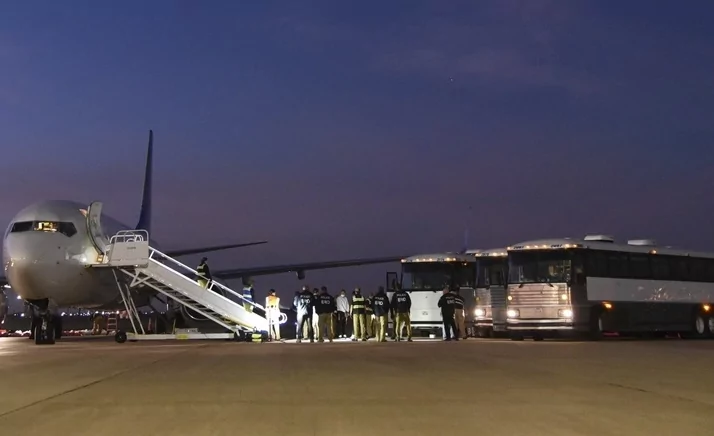
Former President Donald Trump faces steep challenges to carrying out the largest deportation operation in American history, as logistics, cost, and political considerations could get in the way of removing illegal immigrants en masse.
Trump has remained light on details when it comes to how many noncitizens he would deport if he wins a second term in office. His campaign has only said it would begin with “the nearly 500,000 convicted criminals who Kamala Harris has allowed to remain in the country.”
But if Trump attempts to exceed historical norms, the deportation effort could have wide-ranging impacts that extend beyond the staffing limitations of U.S. Immigration and Customs Enforcement. He could be met with legal challenges and obstacles from Congress, as he was in his first term in the White House.
Meanwhile, he would be forced to weigh a possible drop in economic output plus the political fallout from any family separations.

Trump unclear on mass deportation scale
At scale, Trump’s campaign pledge could affect as many as 11 million people residing in the country illegally. He and his running mate, Sen. J.D. Vance (R-OH), have claimed at recent public events that the illegal immigrant population is 21 million.
“About a million of those people have committed some form of crime in addition to crossing the border illegally,” Vance said at a September debate with Democratic vice presidential nominee Gov. Tim Walz (D-MN). “I think you start with deportations on those folks.”
For context, no administration has ever attempted a pointed deportation “operation,” as his campaign has promised, so Trump’s goal has a low threshold to surpass.
The Obama administration averaged higher yearly removals than the Trump administration, which totaled 1.5 million deportations over four years. The Biden administration, for its part, is on track to match Trump’s numbers, according to the Migration Policy Institute.
It has done so, in part, by relying more heavily on “returns,” a type of deportation in which migrants agree to leave voluntarily without a formal order.

Trump faces limitations over manpower and cost
Deportations en masse have generally not occurred because each immigrant is individually ordered deported by a federal immigration judge, not by the ICE officers tasked with carrying out the arrest.
Even the deportation of 1 million illegal immigrants from the interior of the country in a single year would be challenging for an agency used to removing 100,000 to 400,000 each year over the past two decades.
David Bier, director of immigration studies at the libertarian Cato Institute, said, “There is no scenario where ICE can carry out 21 million removals in four years.”
“The manpower, detention space, and air resources are simply not there,” Bier wrote in an email. “Obviously, using the military, as Trump wants to do, would significantly increase the capacity. The military assets are effectively limitless if the leadership signs off on their use for this purpose, and it is legal.”
ICE is broken into two parts: Enforcement and Removal Operations and Homeland Security Investigations. HSI is not directly involved in immigration, whereas ERO officers are the employees who track down, arrest, detain, and remove individuals.
ERO largely contracts out its detention facilities, but its roughly 6,000 employees nationwide would be responsible for processing potentially millions of immigrants. ICE also lacks the detention space for such an operation.
A second Trump administration could compensate by ramping up funding, but doing so would require cooperation from Congress. To arrest and deport 1 million people costs U.S. taxpayers roughly $20 billion, according to a CBS News analysis published Thursday.
If Republicans regain unified control of Washington in November, Trump will have more flexibility. But the House is most at risk of flipping to Democrats on Election Day, meaning he could be forced to pursue immigration policy in divided government.
In his last administration, Trump failed to win billions in border wall funding despite forcing the longest shutdown in government history.

Looming legal challenges
Another possible obstacle for Trump would be legal challenges. In 2019, the Trump administration attempted to put in place a policy that would allow the government to expedite deportations for illegal immigrants who could not prove they had been in the country for at least two years.
But the American Civil Liberties Union, among others, sued in the U.S. District Court for the District of Columbia on behalf of smaller immigrant rights groups that said those being targeted were not given due process.
Similar lawsuits can be expected if Trump moves forward with similar plans.
Most recently, Trump’s interest in invoking the Alien Enemies Act of 1798, which allows a president to deport any person from a country that the United States is at war with, has faced skepticism from some legal experts.
Political backlash to family separations
Family separations, a term that garnered national attention in 2018 when the Trump administration took children from their parents at the border in order to detain and prosecute the adult, could return as a political headache if millions of illegal immigrants are deported.
Trump faced fierce backlash in his first term for the policy, which Democrats and immigrant rights groups denounced as inhumane.
If the deportation was carried out at full-scale, roughly 5.5 million U.S.-born children have a parent who is an illegal immigrant.
Trump told NBC News in August that he would make “provisions” for mixed-status families, or those households in which some members are in the country illegally and others not, but that “we have to get the criminals out.”
Impact on the economy
Workers who are illegal immigrants contribute more than $96 billion in federal, state, and local tax, according to Center for Migration Studies.
The economic effect of millions of deportations would be “essentially the inverse” of what the Congressional Budget Office found from the influx of immigrants into the country over the past three years.
Trump and Vance have blamed illegal immigration for suppressing the wages of American-born workers, but immigrant rights groups have argued that government revenues would be cut about $700 billion and Gross Domestic Product could fall substantially if millions of workers are pushed out of the country, with industries such as agriculture, construction, and hospitality affected the most.

“In the short term, we will see supply chain issues like we saw in 2021. Prices will increase as less is produced, and the economy will shrink,” Bier wrote in an email. “There will be a downshift in US worker employment within industries toward more manual labor jobs and away from managerial and language-intensive jobs.”
CLICK HERE TO READ MORE FROM THE WASHINGTON EXAMINER
MPI, an immigration research group in New York, said that while such a large-scale deportation could initially deter some migrants from making the journey to the U.S. in the short term, it would not quell the desire of countless millions to emigrate.
“Without addressing the underlying drivers of migration, these policies may lead to a change only in individuals’ migration strategies rather than a noticeable reduction of irregular migration overall,” the MPI report stated.





